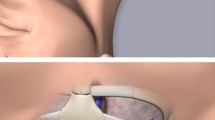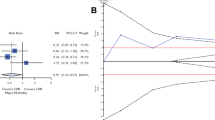Abstract
Purpose
The purpose of this study was to investigate the safety, efficacy, and subjective satisfaction of peripherally inserted central catheters (PICCs) in terminally ill cancer patients.
Methods
All PICCs were inserted by an interventional radiologist with radiological guidance. We monitored the occurrence of PICC-related complication and evaluated the patient-perceived satisfaction for PICC using semi-structured questionnaire.
Results
A total of 36 terminally ill cancer patients underwent PICC. Three patients had 2 PICC insertions; hence, finally 39 episodes during 829 PICC days were analyzed. All procedures were completed without any procedure-related complication. The median catheter life span was 19.0 days (95 % CI, 14.1–23.9). Thirty-four cases maintained the PICC until the intended time, while the other 5 cases (12.8 %; 6.1/1000 PICC days) were premature PICC removals. Totally 10 complications (25.6 %; 12.3/1000 PICC days) were reported including premature removals (n = 5), trivial bleedings (n = 3), and thrombophlebitis (n = 2). Patients reported that the procedure was not distressing (42 %), a little distressing (36 %), or distressing (21 %). Of 30 patients who had preserved cognitive function at fifth day, most patients (n = 25, 83 %) reported more comfort although the other 5 patients reported no change (n = 3) or less comfort (n = 2).
Conclusions
PICCs were safely inserted and showed favorable maintenance rate with acceptable complications. Additionally, most of the patients felt that parenteral access became much comfortable after PICC insertion. When considering the characteristics of terminally ill cancer patients, poor general condition and a limited period of survival, PICC could be a safe and effective method for intravenous access.

Similar content being viewed by others
References
Cleeland CS (2000) Cancer-related symptoms. Semin Radiat Oncol 10(3):175–190
Mercadante S, Ferrera P, Girelli D, Casuccio A (2005) Patients’ and relatives’ perceptions about intravenous and subcutaneous hydration. J Pain Symptom Manag 30(4):354–358. doi:10.1016/j.jpainsymman.2005.04.004
Walshe LJ, Malak SF, Eagan J, Sepkowitz KA (2002) Complication rates among cancer patients with peripherally inserted central catheters. J Clin Oncol Off J Am Soc Clin Oncol 20(15):3276–3281
Ng PK, Ault MJ, Ellrodt AG, Maldonado L (1997) Peripherally inserted central catheters in general medicine. Mayo Clin Proc 72(3):225–233. doi:10.1016/s0025-6196(11)64753-8
Smith JR, Friedell ML, Cheatham ML, Martin SP, Cohen MJ, Horowitz JD (1998) Peripherally inserted central catheters revisited. Am J Surg 176(2):208–211
Gunst M, Matsushima K, Vanek S, Gunst R, Shafi S, Frankel H (2011) Peripherally inserted central catheters may lower the incidence of catheter-related blood stream infections in patients in surgical intensive care units. Surg Infect 12(4):279–282. doi:10.1089/sur.2008.058
Kim HJ, Yun J, Kim HJ, Kim KH, Kim SH, Lee SC, Bae SB, Kim CK, Lee NS, Lee KT, Park SK, Won JH, Park HS, Hong DS (2010) Safety and effectiveness of central venous catheterization in patients with cancer: prospective observational study. J Korean Med Sci 25(12):1748–1753. doi:10.3346/jkms.2010.25.12.1748
Park K, Lim HG, Hong JY, Song H (2014) Safety and efficacy of peripherally inserted central catheters in terminally ill cancer patients: single institute experience. Korean J Hosp Palliat Care 17(3):179–184
Morita T, Tei Y, Tsunoda J, Inoue S, Chihara S (2001) Underlying pathologies and their associations with clinical features in terminal delirium of cancer patients. J Pain Symptom Manag 22(6):997–1006
Lundh Hagelin C, Seiger A, Furst CJ (2006) Quality of life in terminal care--with special reference to age, gender and marital status. Support Care Cancer : Off J Multinational Assoc Support Care Cancer 14(4):320–328. doi:10.1007/s00520-005-0886-4
Lee GJ, Ahn HS, Go SE, Kim JH, Seo MW, Kang SH, Yang YR, Lee MY, Lee KO, Chun SH, Jin JY (2015) Patient’s factors at entering hospice affecting length of survival in a hospice center. Cancer Res Treatment : Off J Korean Cancer Assoc 47(1):1–8. doi:10.4143/crt.2013.148
Llobera J, Esteva M, Rifa J, Benito E, Terrasa J, Rojas C, Pons O, Catalan G, Avella A (2000) Terminal cancer. Duration and prediction of survival time. Eur J Cancer (Oxford, England : 1990) 36(16):2036–2043
Yamada R, Morita T, Yashiro E, Otani H, Amano K, Tei Y, Inoue S (2010) Patient-reported usefulness of peripherally inserted central venous catheters in terminally ill cancer patients. J Pain Symptom Manag 40(1):60–66. doi:10.1016/j.jpainsymman.2009.11.327
Sansivero GE (2000) The microintroducer technique for peripherally inserted central catheter placement. Journal of intravenous nursing : the official publication of the intravenous nurses society 23 (6):345–351
McGee DC, Gould MK (2003) Preventing complications of central venous catheterization. N Engl J Med 348(12):1123–1133. doi:10.1056/NEJMra011883
Li J, Fan YY, Xin MZ, Yan J, Hu W, Huang WH, Lin XL, Qin HY (2014) A randomised, controlled trial comparing the long-term effects of peripherally inserted central catheter placement in chemotherapy patients using B-mode ultrasound with modified Seldinger technique versus blind puncture. Eur J Oncol Nurs 18(1):94–103. doi:10.1016/j.ejon.2013.08.003
Yap YS, Karapetis C, Lerose S, Iyer S, Koczwara B (2006) Reducing the risk of peripherally inserted central catheter line complications in the oncology setting. Eur J Cancer Care 15(4):342–347. doi:10.1111/j.1365-2354.2006.00664.x
Cheong K, Perry D, Karapetis C, Koczwara B (2004) High rate of complications associated with peripherally inserted central venous catheters in patients with solid tumours. Intern Med J 34(5):234–238. doi:10.1111/j.1444-0903.2004.00447.x
Mermel LA (2000) Prevention of intravascular catheter-related infections. Ann Intern Med 132(5):391–402
Author information
Authors and Affiliations
Corresponding author
Ethics declarations
Conflict of interest
The authors declare that they have no conflict of interest.
Disclosure form
All procedures performed in studies involving human participants were in accordance with the ethical standards of the institutional and/or national research committee and with the 1964 Helsinki Declaration and its later amendments or comparable ethical standards.
Rights and permissions
About this article
Cite this article
Park, K., Jun, H.J. & Oh, S.Y. Safety, efficacy, and patient-perceived satisfaction of peripherally inserted central catheters in terminally ill cancer patients: a prospective multicenter observational study. Support Care Cancer 24, 4987–4992 (2016). https://doi.org/10.1007/s00520-016-3360-6
Received:
Accepted:
Published:
Issue Date:
DOI: https://doi.org/10.1007/s00520-016-3360-6




